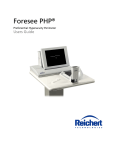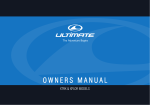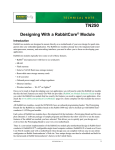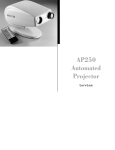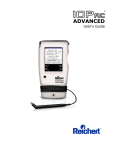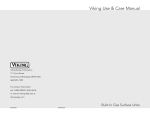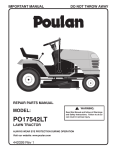Download Reichert AP250 User`s guide
Transcript
AP250 Automated Chart Projector User's Guide ©2011 Reichert, Inc. Reichert is a registered trademark of Reichert, Inc. The information contained in this document was accurate at time of publication. Specifications subject to change without notice. Reichert, Inc. reserves the right to make changes in the product described in this manual without notice and without incorporating those changes in any products already sold. Federal law restricts this device to sale by or on the order of a physician. ISO 9001/13485 Certified – Reichert products are designed and manufactured under quality processes meeting ISO 9001/13485 requirements. No part of this publication may be reproduced, stored in a retrieval system, or transmitted in any form or by any means, electronic, mechanical, recording, or otherwise, without the prior written permission of Reichert, Inc. 2 13800-101-Rev. E Contents 13800-101-Rev. E Introduction 4 Safety Precautions 4 110V / 230V Operation 4 Package Contents 4 Accessories 4 Instrument Components 5 Installation 6 Alignment / Focusing Remote Control Programming Masking Options 7 Care and Maintenance Slide Library 10 Letter Sizing Chart - Feet 12 Letter Sizing Chart - Meters 13 Technical Specifications 14 Symbol Information 14 Reichert Product Warranty 15 8 9 9 11 3 Introduction Congratulations on your purchase of the AP250 Automated Projector. In the field of subjective refraction, the AP250 is used for measuring visual acuity. This User’s Guide is designed as a training and reference manual. We recommend you carefully read and follow the steps in this guide to ensure optimum performance from your new instrument. Please retain this guide for future reference and to share with other users. For additional copies or assistance with this product, contact the Reichert Customer Service Department. Contact information is provided on the back of this manual. Safety Precautions • Except for changing the Halogen bulb and replacing the fuses, any repair or service on the AP250 must be performed only by authorized Reichert personnel. • Only qualified and trained personnel should operate the AP250. • Training for operating personnel is the sole responsibility of the owner. • Plug the AP250 into a grounded electrical receptacle. Do not remove cover. Otherwise, electrical shock can occur. Do not remove or obstruct the grounded electrical connection or damage to the instrument or injury to the operator may occur. • The line voltage setting on the AP250 power input module should agree with the local line voltage. Otherwise, damage to the instrument or injury to the operator may occur. • Do not obstruct any ventilation slots. • Do not use the AP250 in the presence of flammable anesthetics and volatile solvents such as alcohol, benzine or similar agents. • Do not set-up the instrument in humid conditions. Avoid dripping or splashing water near the instrument. • Use only accessories specified in this manual. If you intend to use other accessories, consult an authorized Reichert dealer or our Customer Service Department. • Never look directly into the AP250's light source. • Disconnect the power cable prior to replacing the AP250's Halogen bulb. Allow the lamp to cool-down before touching or injury (burning) may occur. 4 110 V / 230 V Operation To ensure proper operation, check the fuse voltage setting on the power input module. The factory setting is 110 V. If 230 V operation is desired, remove the fuse holder and pull out the white plasitc insert. Rotate the insert so "230" appears in the window when inserted in the fuse holder. Remove the 500 mA fuses and replace them with 250 mA fuses. See page 14 for fuse types. Install the fuse holder in the power input connector. Package Contents Your new AP250 Automated Projector and accessories were carefully packed and checked prior to shipment; however, please check condition and contents upon delivery. In addition to your AP250, this shipment should include: 1 Spare Halogen Bulb 1 Power Cord 1 Dust Cover 1 Remote Control 2 Hexagon Keys (3 mm and 5 mm) 2 Spare Fuses 500 ma (110 V) 2 Spare Fuses 250 ma (230 V) 1 Pair of red/green spectacles 1 Pair of polarizing spectacles 4 AAA-sized batteries 1 Wall mount (2 pieces) 1 Screen Accessories 13813 Flange Style Halogen Bulb ( pre S/N 10897-02) 13806 2-Pin Halogen Bulb (post S/N 10896-02) 13816 Remote Control 13814 Red / Green Spectacles 13815 Polarizing Spectacles 4013110 Dust Cover 11808 Projection Screen 12090 Table Mount 12091 Wall Mount 12092 Instrument Stand Mount 12096 Floor Stand Mount 13800-101-Rev. E Instrument Components 1. Projector Head 7 2. Projection Lens 13 3. Remote Detection Window 4. Remote Control Unit 5. Mounting Bracket 6. Clamp-down Screw 8 9 7. Power Switch 8. Fuse Compartment with Voltage Indicator 9. Power Input 10. Halogen Bulb Housing 11. Chart Focusing Control 12. Distance Focusing Control 13. RS232C Serial Port 1 2 3 10 4 11 12 5 6 13800-101-Rev. E 5 Installation The AP250 should be installed according to the following procedures: 1. If using a wall mount, it is best to locate a wall stud to support the projector’s weight. 2. The following distances are important in the set-up of a refracting room: REFRACTING DISTANCE (RD) The distance from the patient’s eye to the screen. PROJECTION DISTANCE (PD) The distance from the slide to the screen. LETTER HEIGHT (LH) The height of a 20/200 character should be equal to the refracting distance times the tangent of 50 minutes of arc or .014545. LH (inches) or (mm) = RD (inches) or (mm) x .014545 For example, a refracting distance of 240 inches (20 feet) will require a 20/200 height of 3.49 inches (240 inches x .014545 = 3.49 inches) or for a 4000 mm (4 m) refracting distance, you will require a letter height of 58.18 mm (4000 mm x .014545 = 58.18 mm). 4. Install the projector screen. 5. If attaching the AP250 to a mount, loosen the clampdown screw (see page 5, #6) and insert the projector mount onto the ball. Tighten screw, allowing for some movement of the projector for final positioning. Fully tighten the screw after final adjustment and alignment of the system. 6. Make sure the voltage indicator number corresponds with the available local mains. 7. Plug power cord into AC inlet and into a wall power outlet. Set the power switch to the “ON” position. NOTE: For proper operation, the remote typically needs to be more than 5 ft (1.5 m) away from the projector. Make sure no objects that could interrupt remote control signals are located between remote control and projector. 3. Determine the refracting distance by measuring the distance from the patient to the screen. Please refer to Figures 1 and 2, below, which show combinations of refracting and projection distances achievable with this system. PROJECTION RANGE LIST Projection Distance 6 Minimum Refracting Distance Maximum Refracting Distance ft m ft m ft m 10 3.0 7.4 2.3 11.6 3.5 11 3.3 8.2 2.5 12.7 3.9 12 3.6 8.9 2.7 13.0 4.2 13 3.9 9.6 2.9 15.0 4.6 14 4.2 10.4 3.2 16.2 4.9 15 4.5 11.1 3.4 17.3 5.3 16 4.8 11.8 3.6 18.5 5.6 17 5.1 12.6 3.8 19.6 6.0 18 5.4 13.3 4.1 20.8 6.3 19 5.7 14.0 4.3 21.9 6.7 20 6.0 14.8 4.5 23.1 7.0 21 6.4 15.5 4.7 24.3 7.4 22 6.7 16.2 4.9 25.4 7.7 23 7.0 17.0 5.2 26.6 8.1 24 7.3 17.7 5.4 27.7 8.4 25 7.6 18.4 5.6 28.9 8.8 26 7.9 19.2 5.8 30.0 9.2 Figure 1 - Projection Range List in feet and meters. 30 REFRACTING DISTANCE (ft) PROJECTION RANGE GRAPH 25 20 Maximum 15 10 Minimum 5 10 11 12 13 14 15 16 17 18 19 20 21 22 23 24 25 26 PROJECTION DISTANCE (ft) Figure 2 - Projection Range Graph in feet. 13800-101-Rev. E Alignment / Focusing The AP250 can be optimally focused at projection distances between 10 ft (3 m) and 26.5 ft (8 m) when the patient and projector are equidistant from the projection screen. 2. Check the three-dimensional alignment of the system. To optimize the alignment, it may be necessary to angle the screen to direct light towards the patient’s head. As a test, place a mirror on the screen. The light should project where the patient's head would be (see Figure 3). 3. Adjust the image positioning on the screen. It may be necessary to adjust the projector and the screen. Secure projector by tightening mounting screw. 4. Determine the proper letter size based on the refracting distance used. Refer to the Letter Sizing Charts at the end of this manual (pages 12 & 13). Patient Spot of Light on Wall à 1. Project a 20/200 or 0.1 character onto the key. screen by pressing the à Mirror Screen AP250 Figure 3 - Checking three-dimensional alignment. 5. Attach Letter Sizing Chart to the screen. 6. Open the projector cover by removing the hexagon screw under the front of the AP250. 7. Move the AP250's focusing controls (see page 5, # 11 & 12) until the 20/200 or .01 "Z" is in sharp focus and fills the bracket on the Letter Sizing Chart, as shown in Figure 3. NOTE: To obtain longer refracting distances in small rooms, a mirror or system of mirrors can be used. A high quality front-surface mirror is required. See Figure 4 as an example of a short room with a full refracting distance of 20 feet. NOTE: To prevent interference with the operation of the Remote Control window, care should be taken not to position any bright lights directly toward the front of the AP250. Patient Mirror Patient Screen Small Mirror AP250 Figure 4 - Using a mirror system in a small room. WARNING: Proper setting of the focus and distance controls requires that the projector cover be open while the instrument is plugged in and turned on. Utilize only the distance and focus controls while the cover is open. Do not touch any other components under the cover or personal injury may result. 13800-101-Rev. E 7 Remote Control The AP250 is operated by an intuitive remote control that is divided into various sections for ease of use (see figure 5). When the power switch on the back of the instrument is in the ON position, slides can be projected by simply pushing any button. The Lamp ON / OFF button can be used to turn the lamp off at anytime. Otherwise, the AP250 lamp shuts off automatically after 10 minutes of non-use. To use the AP250, simply press any button on the remote control and the respective slide will be displayed. Red / Green or Polarizing filters, and a variety of character / line isolation masks can be applied to almost any chart by pressing the appropriate buttons. NOTE: The red indicator light flashes when pressing any remote control function, indicating that the control is functioning properly. Indicator Light Binocular Balance Test Program Keys Red/Green Test Lamp On/Off Children Charts Illiterate Charts Special Charts Filters Number Charts Letter Charts Eye Diagram Masking Options Figure 5 - Remote Control Unit 8 13800-101-Rev. E CHANGING THE EMISSION CODE Using the Programed Sequence The codes of the projector and remote control are factory set to 00. It is advisable to change the emission code of the Remote Control unit if several projectors are used in close proximity to one another to avoid interaction. 1. Press the Program Key (1 or 2). To change the code, follow the steps below: 1. Open the battery compartment on the rear of the remote control (see Figure 6). Use a small pointed object to select a new switch position combination. Sixteen combinations are possible. 2. Turn the power switch on the rear of the projector to the OFF position. With the Remote Control approximately 5 ft (1.5 m) away from the AP250's Remote Detection Window, press the IN Program Key while simultaneously switching on the projector. You may require an assistant to help. 3. The AP250 will emit a short beep. Continue holding the IN Program Key until you hear a longer beep. The code setting is now complete. PROGRAMMING SLIDE SEQUENCES Switch UP = ON 1 2 3 2. Press the NEXT or BACK Key to display the slides within your program sequence. Interrupting a Slide Sequence at a Defined Point 1. Press the Program Key (1 or 2) you want to interrupt. 2. Press the IN Program Key. 3. Press the NEXT Program Key until the slide appears that you want to conclude the sequence. 4. Press the OUT Program Key. The new slide sequence is now stored. Editing a Stored Slide Sequence 1. Press the Program Key (1 or 2) you want to edit. 2. Press the NEXT Program Key until the slide to be changed appears on the screen. 3. Press the IN Program Key. 4. Press the new slide. 5. Confirm the new slide selection by pressing the NEXT Program Key. 6. Press the OUT Program Key. The new slide sequence is now stored. MASKING OPTIONS 4 The AP250's masking options allow the operator to isolate horizontal lines, vertical lines and individual charts. See Figure 7 below for functions of masking buttons. Switch Settings APPLIES HORIZONTAL Mask AND moves mask Upwards Battery Compartment APPLIES Vertical Mask AND moves mask to the Left Figure 6 - Changing the Switch Settings APPLIES Vertical Mask AND moves mask to the right The AP250 can record two (2) custom slide sequences, including masks. Follow the steps below to store, edit and interrupt a programed slide sequence. Storing a Slide Sequence 1. Press Program Key 1 or 2. 2. Press the IN Program Key. 3. Press the buttons of the desired slides, in the desired order, followed by the NEXT button after each slide. 4. After pressing the final slide of the sequence, press the OUT Program Key. The slide sequence is now stored in the selected order as program 1 or 2. 13800-101-Rev. E APPLIES horizontal Top horizontal Mask AND moveS Mask or RETURN mask downwards TO full view isolates individual characters Figure 7 - Functions of masking buttons 9 Care and Maintenance WARNING: Risk of electric shock. Always disconnect the power cord from the wall and the instrument before performing any of the following care and maintenance procedures. CHANGING THE HALOGEN BULB WARNING: Never touch a Halogen Bulb with bare hands as fingerprints will shorten the bulb life. Never remove a bulb that has recently been in use as it will be very hot. Wait until it has cooled and use gloves or a thick cloth when handling any halogen bulb. 1. Open the top portion of the projector housing by loosening the 3 mm hexagon screw located underneath the front portion of the AP250 head. 2. Remove the cover from the bulb housing (page 5, #10). 3. Remove the bulb by lightly pulling upwards on it. CHANGING THE REMOTE CONTROL BATTERIES 1. Open the battery compartment on the rear side of the remote control (see Figure 6). 2. Remove the batteries. 3. Insert four new AAA batteries and close battery compartment. CAUTION: Observe polarization markings on the inside of the battery compartment and insert batteries accordingly. CHANGING THE VOLTAGE / REPLACING FUSES WARNING: Risk of electric shock. Always disconnect the power before changing fuses. CAUTION: Make sure the rating of the inserted fuses complies with the rating specified on the rating plate (see page 5, #8). 4. Position a new bulb over the pins and gently push it down until fully seated. 1. Pull out the fuse holder in the fuse compartment located on the backside of the AP250 (see page 5, #8). 5. Replace the bulb housing cover. 2. Replace blown fuses. 6. Close the top portion of the projector housing and tighten the cover screw. 3. Insert the fuse holder into the fuse compartment until it snaps in. NOTE: If illumination is not uniform, call your Reichert dealer or our Customer Service department. 4. Reconnect the power cord and turn the projector on. CLEANING The exterior housing can be cleaned with a mild soap solution applied to a clean, soft cloth. Halogen Bulb The projector lens and window for remote detection can be cleaned with a soft, clean, optics-safe cloth. To clean the remote control, wipe with a soft, clean, dry cloth. To clean the screen, wipe with a soft, clean, dry cloth. CAUTION: The screen is very susceptible to scratches and fingerprints. Handle with care. Figure 8 - Replacing the Halogen Bulb. 10 13800-101-Rev. E Slide Library Letter Charts Number Charts Illiterate Charts Children Charts Special Charts Astigmatism Red-Green Cross Cylinder Phoria Phoria with fixation Minute Stereo Fixation point Vertical Coincidence Binocular Balance Vertical Line Horizontal Line Worth 13800-101-Rev. E Eye Schematic 11 Letter Sizing Chart - Feet REFRACTING DISTANCE FEET 30 28 26 24 22 20 18 16 14 12 10 8 29 29 27 27 25 25 23 23 21 21 19 19 17 17 15 15 13 13 11 11 9 9 7 7 30 28 26 24 22 20 18 16 14 12 10 8 Figure 9 - Letter Sizing Chart in feet 12 13800-101-Rev. E Letter Sizing Chart - Meters REFRACTING DISTANCE METERS 9.00 9.00 8.75 8.75 8.25 8.25 7.75 7.75 7.00 7.25 7.25 7.00 6.50 6.75 6.75 6.50 6.25 6.25 5.75 5.75 5.25 5.25 4.75 4.75 4.25 4.25 3.75 3.75 3.25 3.25 2.75 2.75 2.25 2.25 8.50 8.00 7.50 6.00 5.50 5.00 4.50 4.00 3.50 3.00 2.50 2.00 8.50 8.00 7.50 6.00 5.50 5.00 4.50 4.00 3.50 3.00 2.50 2.00 Figure 10 - Letter Sizing Chart in meters 13800-101-Rev. E 13 Technical Specifications Projection Distance Refraction Distance Number Of Test Charts Masks 10 Ft (3 M) To 26.5 Ft (8 M) 7.4 Ft (2.3 M) To 30 Ft (9.2 M) 33 Standard Test Charts - Red/Green, Polarization, Single Horizontal Lines, - Single Vertical, Single Letters And Single Numbers. Tilt Range Of Projector Automatic Switch-Off Power Requirements Line Voltage Line Frequency Line Fuse On 110V Line Fuse On 230V Projection Lamp Grounding Wire ± 15° After 10 Min. Without Operation. 110 V; 230 V; Margin ± 10% 50 To 60 Hz 500 Ma, Slow Blow/250 V 250 Ma, Slow Blow/250 V 12V/20W Halogen Bulb Instrument To Be Connected Only To Proper Outlets With Correct Ground Wire. Protection Class Degree Of Protection Power Consumption Dimensions (Head Only) Height Width Depth Color Weight 1 IP 21 40 VA 7" (17.78 Cm) 8" (20.32) 13" (33.02) White With Grey Accents 12 Lbs (5.4 Kg) Symbol Information The following symbols appear on the AP250: CAUTION - An instruction that draws attention to the risk of damage to the product. Consult accompanying documents. Protective Earth (Ground) WARNING - Risk of electric shock. Consult accompanying documents. WARNING - An instruction that draws attention to the risk of injury or death. Consult accompanying documents. Alternating Current Power Waste of Electrical and Electronic Equipment 14 Date of Manufacture 13800-101-Rev. E Reichert Product Warranty This product is warranted by Reichert, Inc. against defective material and workmanship under normal use for a period of one year from the date of invoice to the original purchaser. (An authorized dealer shall not be considered an original purchaser.) Under this warranty, Reichert’s sole obligation is to repair or replace the defective part or product at Reichert’s discretion. This warranty applies to new products and does not apply to a product that has been tampered with, altered in any way, misused, damaged by accident or negligence, or which has had the serial number removed, altered or effaced. Nor shall this warranty be extended to a product installed or operated in a manner not in accordance with the applicable Reichert instruction manual, nor to a product which has been sold, serviced, installed or repaired other than by a Reichert factory, Technical Service Center, or authorized Reichert Dealer. Lamps, bulbs, charts, cards and other expendable items are not covered by this warranty. All claims under this warranty must be in writing and directed to the Reichert factory, Technical Service Center, or authorized instrument dealer making the original sale and must be accompanied by a copy of the purchaser’s invoice. This warranty is in lieu of all other warranties implied or expressed. All implied warranties of merchantability or fitness for a particular use are hereby disclaimed. No representative or other person is authorized to make any other obligations for Reichert. Reichert shall not be liable for any special, incidental, or consequent damages for any negligence, breach of warranty, strict liability or any other damages resulting from or relating to design, manufacture, sale, use or handling of the product. PATENT WARRANTY If notified promptly in writing of any action brought against the purchaser based on a claim that the instrument infringes a U.S. Patent, Reichert will defend such action at its expense and will pay costs and damages awarded in any such action, provided that Reichert shall have sole control of the defense of any such action with information and assistance (at Reichert’s expense) for such defense, and of all negotiation for the settlement and compromise thereof. PRODUCT CHANGES Reichert reserves the right to make changes in design or to make additions to or improvements in its products without obligation to add such to products previously manufactured. CLAIMS FOR SHORTAGES We use extreme care in selection, checking, rechecking and packing to eliminate the possibility of error. If any shipping errors are discovered: 1. Carefully go through the packing materials to be sure nothing was inadvertently overlooked when the unit was unpacked. 2. Call the dealer you purchased the product from and report the shortage. The materials are packed at the factory and none should be missing if the box has never been opened. 3. Claims must be filed within 30 days of purchase. CLAIMS FOR DAMAGES IN TRANSIT Our shipping responsibility ceases with the safe delivery in good condition to the transportation company. Claims for loss or damage in transit should be made promptly and directly to the transportation company. If, upon delivery, the outside of the packing case shows evidence of rough handling or damage, the transportation company’s agent should be requested to make a “Received in Bad Order” notation on the delivery receipt. If within 48 hours of delivery, concealed damage is noted upon unpacking the shipment and no exterior evidence of rough handling is apparent, the transportation company should be requested to make out a “Bad Order” report. This procedure is necessary in order for the dealer to maintain the right of recovery from the carrier. 13800-101-Rev. E 15 Reichert, Inc. 3362 Walden Ave Depew, NY 14043 USA Toll Free: 888-849-8955 Phone: 716-686-4500 Fax: 716-686-4545 Email: [email protected] www.reichert.com Reichert GmbH Hubertstrasse 2 D-82229 Seefeld Germany Phone: +49-8152-993530 Fax: +49-8152-993535 ISO-9001 / 13485 Registered May 2011 13800-101 Rev. E

















